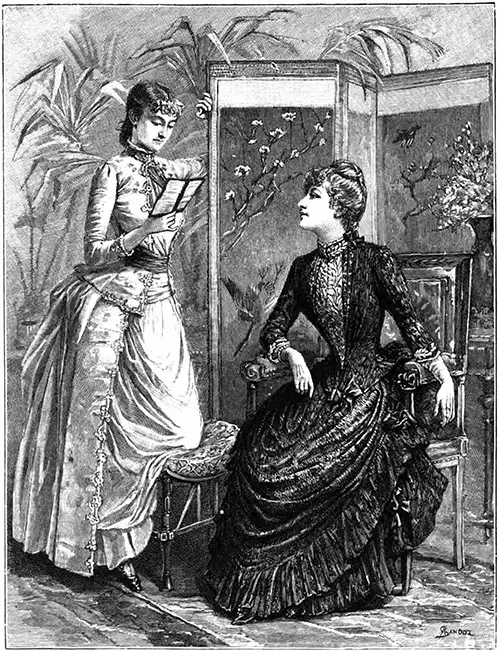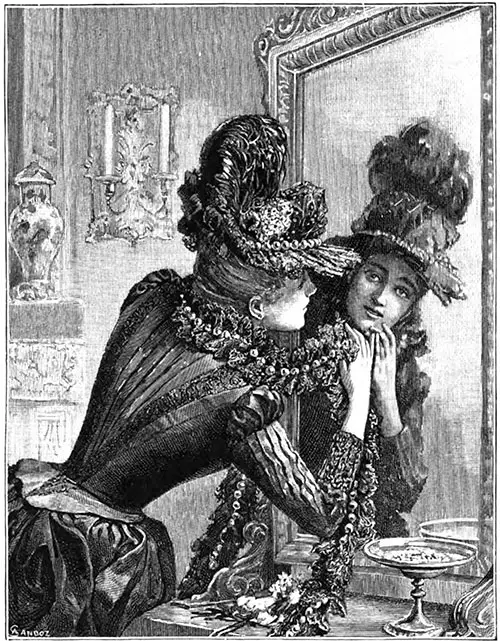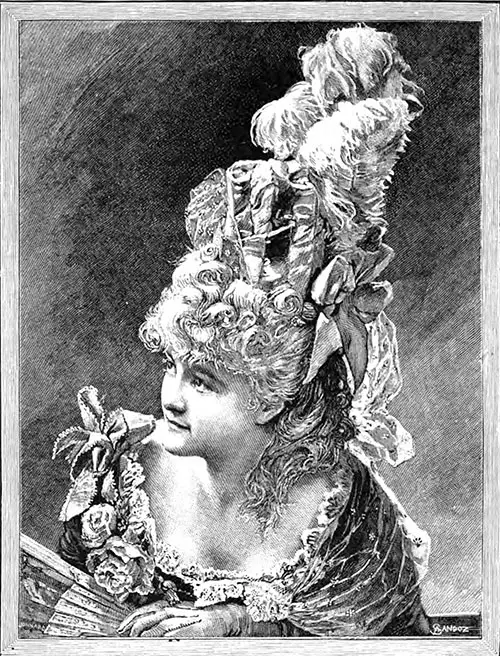Paris Fashions April 1888
The Carnival is over. It was a dreary festivity in Paris. All the women who can lay claim to social distinction had abandoned the city, hurrying off to take part in the Battle of the Flowers waging in the South of France, to pelt and be pelted there with blossoms.
The combat is over, and with Lent the fair Amazons have returned to their homes and have thrown open the doors of their salons. Festivities in Paris have begun long before the advent of Easter. The Duchesse de Maille, the Princesse Mathilde, Mme. Herne, Mme. Boule, Mme. Munckacsy, and Mme. Adam receive weekly or fortnightly.

Costumes Designed by Mmes. Dehais and Philippe
Theatricals are the order of the day at Mme. Goldschmidt's, Mme. Bamberger's, and at Alexandre Dumas'. To take part in these private theatricals, or to assist thereat, furnishes another pretext to our dainty Parisiennes for the display of the most coquettish costumes.
There are costumes appropriate for the varied claims of this round of pleasures: for morning visits, for in-door receptions, for five o'clock teas, for dinner, and the opera.
A medley of charming chiffons rises before my mind's eye, from which it is difficult to choose, and the artistic elegance of which it is next to impossible to describe.
To speak of "passementerie,” "flounces," "pleatings," etc., is to use clumsy words, inadequate to portray the effect of the skillful disposition of line, the harmony of tints produced by the play and shimmer of various textiles brought into combination.
These terms, nevertheless, must be used to convey an idea of some of the results attained by a master-hand, which, in this land of taste, often makes a woman's dress a creation in stuffs, as subtly harmonized and skillfully conceived as is a picture by a great painter.
The art of draping, apparently so simple, is one of the finest attainments of dressmaking. A careless disposition of lines and folds is often the result of long practice, added to a certain instinct, in the disposal of drapery.
Watered or moiré silk is much worn for outdoor costumes. A dress that seemed to pulsate with some of the delicate splendor of the opal was shown me at Dehais and Philippe's. The pale grey silk ground was watered over with rose.
The draped tunic, edged with a pleated flounce, was lifted on one side in undulating lines over a petticoat brilliant with opalized beads. This sparkling embroidery was repeated on the bodice at the throat and wrists and outlined the flow of a chemisette of creamy gauze.

Black Lace Hat and Boa, Designed by Mme. Virot
An outdoor costume consisted of a visite of sapphire blue velvet, fringed with gold beads, and trimmed in front with gold passementerie. The thick silk dress to be worn with this cloak was of the electric blue shade.
The round hat (a creation of Virot) had a flat crown, and wide flaps of black lace over gold. A wing, standing upright, rose at the back from clusters of black feathers, fastened by flowing knots of watered black ribbons; a string of gold beads encircled the crown.
A boa of black lace, through which gleamed a string of gold beads, finished off this rich attire. In contrast to it for simple elegance was a costume of dim red Indian Cashmere, made with a sash of black velvet, and a flat redingote, trimmed with black silk corded passementerie.
In the same show-rooms were to be seen the costumes made for the Duchesse d'Albe, daughter of Due de Fernand, which are to grace the social gatherings of Madrid.
There was an opera-cloak that conveyed suggestions of spring and winter in its combination of young leaf-green velvet and trimming of rich dark sable fur.
An evening dress of electric green satin was made with flat folds forming panels on either side, framing in the floating draperies of green tulle, scintillating with electric green beads, tied here and there with knots of green satin ribbon.
The back of the bodice and train were of green plush, shot with pink; the front of the bodice, cut low à la Tosca, was composed of crossings of satin and tulle. A scarf was wound round the waist.
For the Countess Zichy, whose portrait is to be taken in this dress by Carolus Duran, was a gown of white soft peau de soie, draped with scarfs of tulle spangled with silver.
The bodice, also cut low à la Tosca, was composed of two draperies —one of tulle, the other of peau de soie. A scarf of white silk encircled the waist.
Another costume, of that delicate contrast pink and green, suggested in its make-up the eighteenth-century fashions. It was of beryl-tinted taffetas shot with white, draped at the sides with panels of rosy tulle.
The train of taffetas was lined with pink, assorted to the color of the tulle. The draperies of the bodice, à la Sapho, were held by diamond clasps. The sash was of rose color.
Of severer line and coloring was a dress made for the Comtesse de Pourtales. It was of black terry velvet; a drapery of the softest white silk muslin embroidered with jet covered the front; clusters of black feathers were introduced here and there, as if to keep the muslin in place.
The straight panels at the sides were framed in with feathers. The front of the low body was draped with the white silk muslin held at the shoulders with a cluster of feathers. A black ribbon run through the muslin tucker, served to outline the shoulders and bust.
A picturesque dress was destined for the Countess Wimpffen. It led the mind back to the days of Marie Antoinette. The taffetas were peach-color, that is, rosy puce shot with white. The draped skirt cut open at the side, revealed a cascade of small flounces.
Over the half-opened bodice was to be worn an ample fichu of Brussels lace, held at the waist by a sash of pale blue watered silk.
For Mrs. Mackay was a dress that might have been copied from a picture of the Empire period, skillfully adapted by a longer waist to our modern taste.
The sapphire-blue velvet gown was bound at the waist by a scarf-sash of blue satin; the only trimming—if such it can be called-—was a fichu of old Alemjon lace.
A Court dress, dazzling by its purity of frosted lilywhite effect, was of white India muslin, strewn with silver, and opened in front, displaying rich silver embroidery. The train, of white lampas and silver, was fastened here and there to the skirt with bows of white satin.
The bodice, cut in heart-shape back and front, was draped in front with silver-strewn crape, crossed with silver-embroidered straps. The wide transparent elbow-sleeves were of crape strewn with silver.
From silk to gems the transition is natural. Never was such a profusion of jewels worn in Paris. Neck laces of pearls no longer suffice, clasps of precious stones and brilliants fasten the draperies of the bodices.
Crescents of diamonds are the newest and the favorite fashion. In every bride's corbeille is placed one at least of those delicate young moons in white glittering gems. Suns composed of diamonds, with some rubies introduced at the center, are also fashionable.
The most admired crescents are composed solely of diamonds, the pure luster of which renders best the white radiance of the Queen of Night. Morgan, the fashionable jeweler, occasionally outlines the cold splendor with a rim of sapphires or emeralds, but he does this only by special request.
He would, following his own taste, form those crescents entirely of diamonds; he insures their luminousness by being particularly careful as to the water of the gems he uses.
Butterflies and beetles, which gleam alike effectively placed in the hair or amidst the laces on the bodice of the dress, are also favorites with our beauty-loving ladies.
Two novelties in bracelets may be noted here: one, a tiny spiral of gold, on which fine pearls are threaded, coils round the arm. Another, the Talisman bracelet, is likewise composed of a thread of gold, encrusted with Persian turquoises, some smooth and round, some triangular, engraved in gold with mystic signs.
Let us quit the fascinations of jewels to contemplate those of bonnets and enter the show-rooms of Mme. Virot.
All around us, rise as on tall stems, bonnets hung on stands; two shapes dominate —the little "capote," and the wide-rimmed "Fille Angot," garlanded with flowers.
Here is a Sultan capote, very small, composed of Turkish embroidery, a knot of fine pearls and gold placed in front, the ends falling upon a band of sea-green tulle; above it, a chou of ribbon of old rose color, surmounted by an aigrette of feathery grasses, pink and delicate green, fastened by two gold arrows.
Another attractive head-gear is an "Imperial capote" in gathered crape, a diadem of gold embroideries placed in front, resting on a drapery of tulle; a tulle scarf twisted round the bonnet, and supporting above the diadem a larger cluster of chrysanthemums, running through every shade of cream, golden-yellow, and reddish-brown.
A third original bonnet is made of black feathers encircled by a turban of gold tulle. Two small black birds with tails disposed in the shape of a lyre form the aigrette.
A fourth is of cut straw, fringed with dried oats, and trimmed with a puff of black velvet, through which mingle white and yellow marguerites.
A charming sylvan-tinted bonnet is of moss-green straw, brightened with beetles' wings, wreathed with leaves, and surmounted by an aigrette of daisies and marguerites nestling among loops of green and pink shot tulle.

Directoire Headdress for Fancy Dress Balls
A Directoire bonnet, of smooth Tuscan straw, the broad border of which, lined with moss-green velvet shot with pink, surrounds the head as with an aureole, is adorned with strings and bows of moss-green velvet, and an aigrette of dried oats and ox-eyed daisies.
Fashions in bonnets are decidedly suggestive of the Empire period (1795-1820); the Josephine bonnet is an example of the prevailing style.
Here is one of straw, striped maize and green; a double band of gold embroidery rests above the forehead, placed on puffings of maize tulle. The aigrette is composed of pale roses, reeds, and loops of green ribbon.
Another quaint and dainty bonnet of this old-fashioned style is entirely composed of loops of maize-colored tulle, encircled by a diadem of Japanese roses, the point of which is formed of the flowers' stalks and buds.
Next month we shall be able to state yet more definitely the stuffs, the colors, the arrangement of trimmings which Queen Fashion, who still rules the civilized world from her throne in Paris, will decree. It is yet too early to know in all its details what that edict will be. The final fiat has not yet gone forth.
In the days of the Empire, on Good Friday, Easter Eve, and Easter Day, the élégantes went forth to celebrate the advent of spring, by performing a pilgrimage to Longchamps.
The pilgrimage was the continuation, with a difference, of a similar rite performed by the French ladies in days long gone by.
The earlier pilgrimage had for object to pay honor to the shrine of a saintly hermit who had dwelt under the shadow of Mont Valerien, performing miracles of devotion, and penance, and communion with the spiritual world. The later pilgrimage was to declare the fashions to be worn during the spring.
If Easter came late, and the spring was fairly advanced, the spectacle presented was brilliant; it was always exciting. Deep had been the secrecy hedging round the decision as to the size and forms of the bonnets; the color, the make-up, the materials of the gowns to be henceforth worn that season.
Members of the fair sex outside the charmed circle anxiously waited to see what decisions the festivity would bring to light.
We have no Longchamps now. No sudden proclamation veiled in secrecy till the moment comes for its announcement, attends the rulings of Fashion's whims.
The illustrious milliners and dressmakers make the edicts among themselves, each vying afterwards to out-do the other by the skill and taste with which the decisions adopted are carried out.
The "Empire Fashions" will probably dominate in the coming season. We are happy to say that no particular color will be proclaimed the favorite, and that we may be spared the eye-sore of a tint " done to death."
When artists in dress manipulate a favorite color, the result is charming; for they know how to adapt it to the complexion and the figure of every wearer. When, however, the favorite color is taken up by less practiced hands, applied by less sensitive eyes, the result is disastrous.
But there are signs that green will be much worn—green in its infinite variety of tints; from its light responsive shades, eau de Nil, beryl, and young-leaf-green, passing on through dim mossy green, and delicate willow-green shot with white, to the bronze and olive greens of more sonorous tone.
Stripes will be worn in light woolen dresses—not in contrasting lines, but in two shades of the same tint. There are signs, also, of a favorite mixture of silk and wool of the same color and tint, or of lighter wool over darker silks.
Lace will enter largely into summer costumes for evening wear, and cascades of ribbon promise still to adorn the simple yet fantastic gowns suitable for young girls.
A word about gloves may be aptly spoken here. Parisiennes, from the grisette to the grande dame, are almost more particular about their gloves than about their gowns.
A few years ago they decreed that black gloves should be worn, and ladies throughout Europe and America wore black gloves.
Then they stuck their mignonne hands into tan Suede gloves, and all civilized ladies wore tan Suede gloves: now the tendency in Paris is to affect light gloves, the tender shades of which are Hearing white for ceremonious day receptions.
Johnstone, Violette, “April Fashions: Paris,” in The Woman’s World, Cassell & Company, Limited, London, Paris, New York & Melbourne, Volume I, No. 6, April 1888, p. 285-288.
Editor's Note: Some terminology used in the description of women's clothing during the 1800s and early 1900s has been changed to reflect more modern terms. For example, a women's "Toilette" -- a form of costume or outfit has an entirely different common meaning in the 21st century. Typical terms applied to "toilette" include outfit, ensemble, or costume, depending on context.
Note: We have edited this text to correct grammatical errors and improve word choice to clarify the article for today’s readers. Changes made are typically minor, and we often left passive text “as is.” Those who need to quote the article directly should verify any changes by reviewing the original material.

